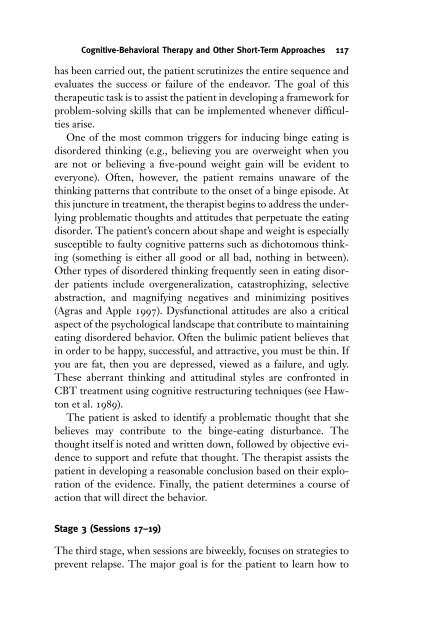Eating Disorders - fieldi
Eating Disorders - fieldi
Eating Disorders - fieldi
You also want an ePaper? Increase the reach of your titles
YUMPU automatically turns print PDFs into web optimized ePapers that Google loves.
Cognitive-Behavioral Therapy and Other Short-Term Approaches 117<br />
has been carried out, the patient scrutinizes the entire sequence and<br />
evaluates the success or failure of the endeavor. The goal of this<br />
therapeutic task is to assist the patient in developing a framework for<br />
problem-solving skills that can be implemented whenever difficulties<br />
arise.<br />
One of the most common triggers for inducing binge eating is<br />
disordered thinking (e.g., believing you are overweight when you<br />
are not or believing a five-pound weight gain will be evident to<br />
everyone). Often, however, the patient remains unaware of the<br />
thinking patterns that contribute to the onset of a binge episode. At<br />
this juncture in treatment, the therapist begins to address the underlying<br />
problematic thoughts and attitudes that perpetuate the eating<br />
disorder. The patient’s concern about shape and weight is especially<br />
susceptible to faulty cognitive patterns such as dichotomous thinking<br />
(something is either all good or all bad, nothing in between).<br />
Other types of disordered thinking frequently seen in eating disorder<br />
patients include overgeneralization, catastrophizing, selective<br />
abstraction, and magnifying negatives and minimizing positives<br />
(Agras and Apple 1997). Dysfunctional attitudes are also a critical<br />
aspect of the psychological landscape that contribute to maintaining<br />
eating disordered behavior. Often the bulimic patient believes that<br />
in order to be happy, successful, and attractive, you must be thin. If<br />
you are fat, then you are depressed, viewed as a failure, and ugly.<br />
These aberrant thinking and attitudinal styles are confronted in<br />
CBT treatment using cognitive restructuring techniques (see Hawton<br />
et al. 1989).<br />
The patient is asked to identify a problematic thought that she<br />
believes may contribute to the binge-eating disturbance. The<br />
thought itself is noted and written down, followed by objective evidence<br />
to support and refute that thought. The therapist assists the<br />
patient in developing a reasonable conclusion based on their exploration<br />
of the evidence. Finally, the patient determines a course of<br />
action that will direct the behavior.<br />
Stage 3 (Sessions 17–19)<br />
The third stage, when sessions are biweekly, focuses on strategies to<br />
prevent relapse. The major goal is for the patient to learn how to









